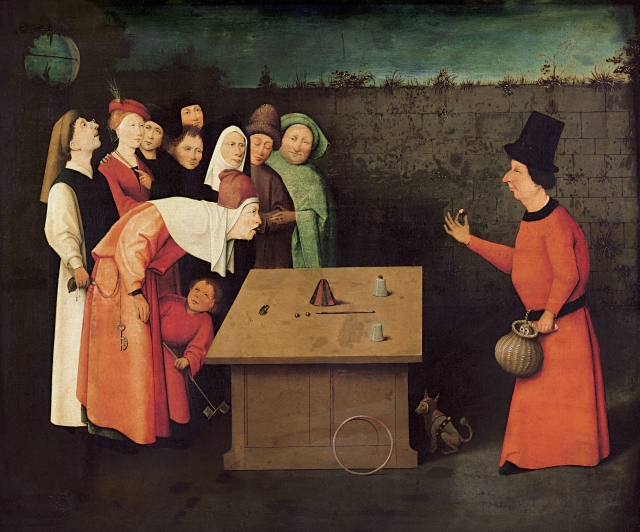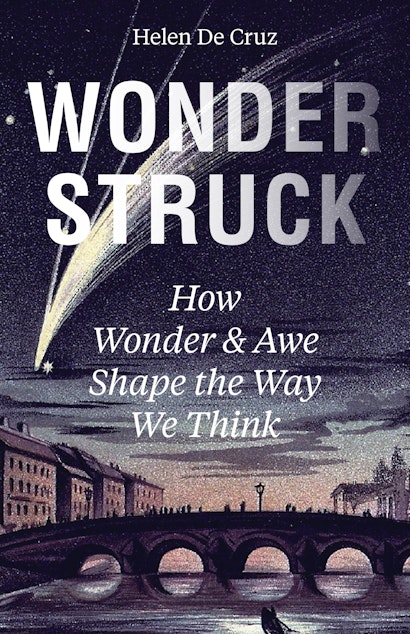Humans love magic. Discord servers, YouTube channels, and Instawitches show that magic is more popular than ever. We enjoy performances where skilled magicians make lemons or elephants appear and disappear before our eyes. Not many academic philosophers discuss magic, however, five centuries ago, prominent Renaissance philosophers, such as Marsilio Ficino (1433–1499), Giovanni Pico della Mirandola (1463–1494), and Giordano Bruno (1548–1600), wrote extensive treatises on the topic. They conceived of magic as the ability to work wonders, and as such it merited close philosophical attention.
In Wonderstruck, I treat magic (like science and religion) as a cognitive technology that harnesses our sense of wonder. Magic connects to wonder in two ways. First, it is the ability to do wondrous things, and hence a kind of power. The word “magic” derives ultimately from the Proto-Indo European word for “power.” Second, magic is passive: it denotes our amazement at wonders we don’t fully understand. The word thaumaturgy ultimately derives from the Greek root thaumazein, which means to wonder. Magic relies on both these aspects: active power and passive wonder.
Consider a magic trick such as the cups and balls, which is cross-culturally widespread and was already mentioned in a letter by Seneca. A ball seemingly vanishes from the magician’s closed fist to reappear under a cup. This is repeated until eventually, the magician makes a lemon or some other object appear (in lieu of a ball) under one of the cups. This trick relies on object permanence, our ability to track occluded objects. The magician uses misdirection (demonstrating the cup is empty) to maneuver the ball under it. We are also beguiled because we attribute intentionality to hand gestures. The sleight of hand used is the French drop, where an object is seemingly transferred while remaining in its original position. At a neural level, there is a clear difference between surprise and wonder: a surprise action, such as a hand swiping a coin away, elicits a different response from a magical action, where a coin disappears into thin air. Adam Smith already theorized about this difference between surprise and wonder in his History of Astronomy (1795): we expect the ball to disappear and reappear in the cups and balls magic trick; we are not surprised, but we “will still wonder, though forewarned of what we are to see.”
While it is tempting to focus on sleight of hand as the essential part of stage magic, magical performances are a more encompassing art that strive to create beauty and a compelling narrative. As stage magician and philosopher Larry Hass explains, witnessing magic can be empowering because as the audience you get to share in the idea that we can achieve the impossible. Stage magician Teller describes magic as a kind of playful epistemology, “the heaviest philosophical ideas you can possibly have, dealt with in the silliest way.”
But magic is more than diversion. In fact, historians, anthropologists, and philosophers have speculated that magical practices lie at the origin of science. Consider a philosopher such as Giordano Bruno. According to Frances Yates’s classic monograph Giordano Bruno and the Hermetic Tradition (1964), he was not burned at the stake for his acceptance of heliocentrism but because he dabbled in hermetic magic. For Bruno, there was no clear dividing line between early science and magic. Consider his definition of natural magic from his On magic (1584):
Magic refers to what happens as a result of the powers of attraction and repulsion between things, for example, the pushes, motions and attractions due to magnets and such things, when all these actions are due not to active and passive qualities but rather to the spirit or soul existing in things. This is called “natural magic” in the proper sense.
According to Bruno, magicians, alchemists, and other dabblers directly manipulate natural materials and observe the effects of their manipulations. Like many other Renaissance magicians, Bruno saw magic as entirely natural: phenomena such as magnetism and electricity were bizarre but not of supernatural origin. By contrast, natural philosophers tried to airbrush strange phenomena away. The origin of science, accordingly, lies in recognizing that strange phenomena are natural and that we can gain control over them.
In addition to Yates, philosophers such as Neurath saw magic as a precursor to science. Otto Neurath (1882–1945) is now best known as one of the co-founders of the Vienna Circle (Wiener Kreis) in 1924, and of the associated philosophical movement known as logical positivism. His philosophy of science is intimately related to his cosmopolitan, progressive political ideas. Neurath wanted to present an ideological alternative to the fascism which was growing in his home country Austria in the 1920s. To stop the far right, he argued that we should aim for clarity of thought, practicality, and improving the lives of people who were hard-hit by the financial crisis of the 1920s. In their 1929 Vienna Circle manifesto, he, together with Hans Hahn and Rudolph Carnap insisted that “the scientific world-conception knows no unsolvable riddle.” Their vision of science was connected to their concern with collective human life, including improving the lives of the working class, public education, and social reform. They presented magic as the intellectual ancestor of science: we should be “returning, after a metaphysical interlude, to a unified picture of this world which had, in a sense, been at the basis of magical beliefs, free from theology, in the earliest times.”
Neurath believed that magic as a human practice is rooted in the same commonsensical, practical thinking that motivates modern science. Science is not elitist, but the opposite: it is a range of practices that people use to help improve their lives. He saw working-class people as resembling Indigenous people, striving to solve concrete problems that their natural and social environments pose. As he explains in Empirical sociology (1931) magicians, like scientists, try to find causal connections in opaque phenomena:
What we have of systematic and orderly action and speech thus seems to go back to primeval systematic orderliness as found in magic. The scientific tendency to link everything with everything else, to regard nothing as indifferent, clearly already belonged to the age of magic.
Unfortunately, the Vienna Circle was forced to stop its activities in a growing climate of fascism and eventually the murder of one of its members (Moritz Schlick). But Neurath points out an important aspect of magic: magic shows our ambition to deal with the wondrous and not shy away from it, to find connections in a causally opaque universe, and to come up with practical solutions based on those connections.
Magic shows how wonder and power are in a dynamic relationship: we are confronted with wonders we can’t explain, but we try our best to figure them out. When you watch a magic show, you can’t but help wonder at the secrets behind each sleight of hand, and a big subgenre of magical performance consists of revealing how classic tricks are accomplished. Wonder is thus not the endpoint of knowledge, but a starting point. As Adam Smith puts it, “Who wonders at the machinery of the opera-house who has once been admitted behind the scenes? In the wonders of nature, however, it rarely happens that we can discover so clearly this connecting chain.” Thus, wonder prompts us to continue to look for hidden connections and to try to untangle how things are done.
Helen De Cruz is the Danforth Chair in the Humanities and professor of philosophy at Saint Louis University. She is the author of Religious Disagreement and (with Johan De Smedt) A Natural History of Natural Theology and the editor and illustrator of Philosophy Illustrated.

